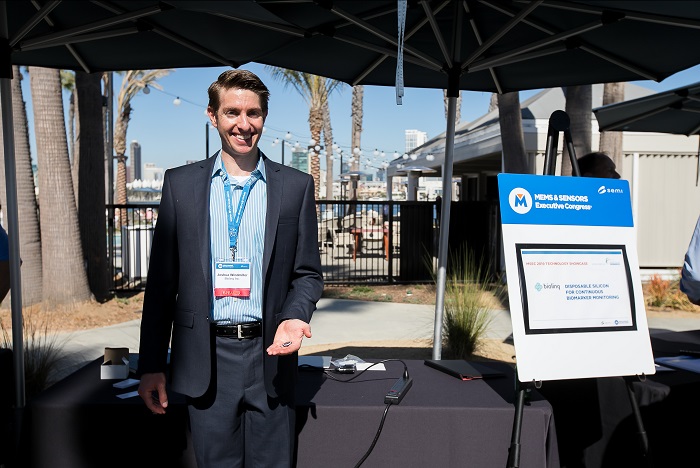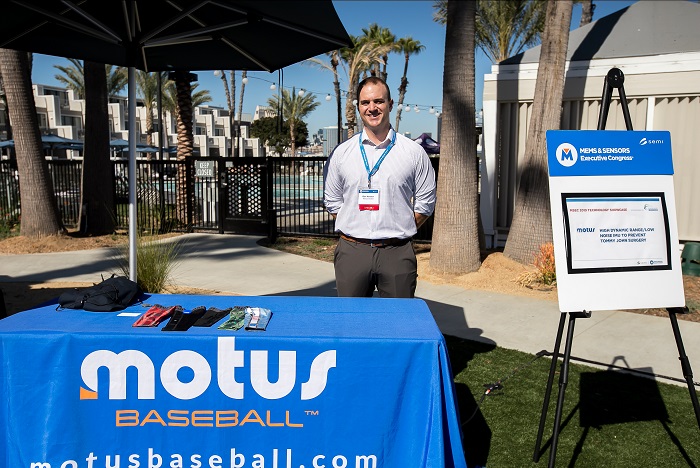By Anne-Françoise Pelé
The 2019 MEMS & Sensors Executive Congress (MSEC), organized by SEMI in Coronado Island, Calif., is a can’t-miss event to take the pulse of the industry from the perspective of some of the community’s movers and shakers. In the course of this two-day conference, the Technology Showcase amplified awareness of the latest, heavily discussed and debated MEMS and sensor technologies and applications.
One of the finalists of this year’s MSEC Technology Showcase is MEMS startup Biolinq. The company has developed a MEMS-enabled microarray sensor technology for measuring blood glucose levels.
Most individuals with diabetes check their blood glucose levels by pricking their fingertips and using a blood glucose meter or a continuous glucose monitor (GCM) to measure the blood glucose. Biolinq has developed a MEMS-enabled microarray sensor technology, worn as a seven-day skin-adhered patch, that streams the user’s metabolic chemistry without accessing blood. It assesses glucose levels, trends, and how food or exercise impacts blood glucose.
“I am convinced we have developed the least invasive method to extract clinical-grade information in real time,” said Joshua Windmiller, chief technology officer of Biolinq.

Joshua Windmiller, Biolinq's CTO. (Image: MSEC)
The device comprises Biolinq’s microsensor array, a printed-circuit board containing a precision electrochemical analog front end, a 32-bit MCU, and a battery. Data is transmitted to an iOS application. As opposed to implantable systems, Windmiller explained, the sensor array monitors interstitial fluid in the dermis, about a fraction of a millimeter just below the skin. Biolinq said it envisions its needle-free MEMS-based GCM as a fingerstick replacement.
“The beauty of it is that you can wear it wherever you like,” Windmiller said. “We have taken this device surfing, running. It’s hermetically sealed and is not limited to any activity.” With its wearable sensor patch, Biolinq aims to redesign the GCM user experience. “This starts with the application process, from opening up a package, pressing on a sensor, and starting the sensor.
The sensor is small (about the size of a nickel) and pain-free, but why can’t it be worn more than seven days?
“The device interfaces with the human body and has a biorecognition element within it,” Windmiller said. After a week, “you just want to get rid of it as it gets pretty itchy.” Then why use a lithium battery and not look into energy harvesting to power the disposable device? Windmiller said the company is exploring other battery chemistries. He told the audience that his Ph.D. work was on biofuel cells, which can harvest the glucose within physiological fluids.
Biolinq’s sensor array, Windmiller added, is not limited to glucose. “There are multiple other metabolites and electrolytes that manifest themselves in the dermis. Some of them have wide-ranging applications for exercise physiology and nutrition.”
Started as Electrozyme LLC in 2012 in La Jolla, Calif., Biolinq has completed two successful clinical trials necessary for FDA approval. It has raised a total of $15 million in Series A funding and employs 25 people.
Preventing Tommy John surgery
Baseball pitchers’ perceived effort does not match actual measured effort during a structured long-toss throwing program, according to a recent study published in the American Journal of Sports Medicine . For the experiment, 60 male high school and college baseball pitchers wore Motus Global sensors in compression sleeves, which measured elbow varus torque, arm velocity, arm slot, and shoulder rotation.
Founded in 2010, Motus Global develops MEMS-based solutions aimed at maximizing performance and reducing the risk of injury, said Benjamin Hansen, vice-president Biomechanics & Innovations at Motus Global.

Benjamin Hansen, Motus Global's vice-president Biomechanics & Innovations. (Image: MSEC)
Its MotusThrow 6-axis, high-dynamic-range inertial measurement unit (IMU), also a finalist in the MSEC Technology Showcase in 2019 and the first of its kind to be approved by Major League Baseball for in-game use, records biomechanical data from every throw made in practice and games. It allows for calculation of torque on the ulnar collateral ligament (UCL), also known as Tommy John Ligament, during a baseball pitch — the fastest recorded human movement.
Motus’ biomechanics workload monitoring software platform accumulates daily workload, acute workload, chronic workload, and acute chronic ratio to help players and coaches personalize training strategies, optimize stamina, and reduce injury risk to the thrower’s arm.
Motus’ MEMS-based IMU, comprising gyroscopes and accelerometers, is also deployed in an FDA-Class 1 medical device: a knee brace aimed at slowing the progression of knee osteoarthritis. It allows for repeatable extraction of gait biomechanics and remotely monitoring of home exercises for knee prehab and rehab applications.
Asked if Motus’ sensing technology could analyze a ballet dancer’s foot load, Hansen answered affirmatively, but added, “we are more focused on complex workload management” in sports such as baseball or cricket.
Headquartered in New York, Motus claims revenue of more than $1 million in 2019 and expects to generate $2.1 million in 2020 revenue. The company plans to reach profitability by the second quarter of 2021.
This is an excerpt from EE Times’ 6 MEMS and Sensors Startups on Fast Track to Grow.
Advertisement
Learn more about Electronic Products Magazine





